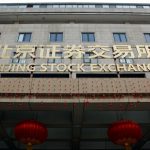SYDNEY/LONDON (Reuters) – China’s big stimulus steps helped keep global stocks near record highs on Friday, while the yen firmed sharply against the dollar after Japan’s former defence minister Shigeru Ishiba looked set to become the next prime minister.
Europe’s benchmark STOXX 600 index edged up 0.2% to touch an all-time high, with the German DAX, France’s CAC 40 and Britain’s FTSE 100 rising in the range of 0.1% and 0.4%.
The dollar weakened by as much as 1.4% to 142.78 yen, reversing earlier gains of about 1% when traders were bracing for the victory of hardline nationalist Sanae Takaichi, a vocal opponent of rising borrowing costs.
Ishiba, who won a closely fought contest in his fifth, and what he called final, attempt to lead the ruling Liberal Democratic Party, has said the Bank of Japan (BOJ) was on the “right policy track” by ending negative rates.
“Ishiba’s victory is a relief for the BoJ as he generally supports the BoJ’s policy normalisation,” said Min Joo Kang, senior economist for South Korea And Japan at ING.
“Moreover, his fiscal policy should focus on reviving the regional economy, which should also support sustainable inflation and growth. We believe that the upcoming inflation results and the Fed’s interest rate actions will be the key to gauge the BOJ’s next move.”
The dollar was last down 1.2% against the yen at 143.03 yen, while futures tracking the Nikkei stock index dropped about 5%.
MSCI’s world stocks index rose 0.2%, also touching a new peak, thanks to a big turnaround in Chinese shares as Beijing ramped up pledges to revive sputtering economic growth.
China’s blue chips jumped 4.5%, bringing their weekly rise to 15.7%, the most since November 2008. Hong Kong’s Hang Seng index also gained 3.6% and was up 13% for the week, its best performance since 1998.
“We think there is further upside but a lot will depend on the specific details in the coming days around the fiscal stimulus,” said Kiran Ganesh, multi-asset strategist at UBS Global Wealth Management.
“If this is something more about stabilisation, then maybe it doesn’t have as big a global economic impact. But if this is a long-term measure to increase the amount of fiscal spending the government is doing, then that could be positive for global growth.”
They see a further upside of close to 10% in Chinese stocks.
As flagged earlier this week, the People’s Bank of China on Friday lowered banks’ reserve requirement ratio by 50 basis points and cut the 7-day reverse repo rate by 20 bps. It also cut the 14-day reverse repo rate by 20 bps, the second reduction this week.
Commodities have had a good week on the back of Chinese stimulus. Iron ore prices clambered back above $100 a metric tonne, copper broke above the key $10,000-a-tonne mark, gold hit another record and silver scaled a 12-year top.
But oil was set for heavy weekly losses on a report that Saudi Arabia was preparing to abandon its unofficial price target of $100 a barrel for crude as it gets ready to increase output. [O/R]
Brent futures edged up 0.1% to $71.69 a barrel, but are down 3.9% for the week. That should be good for global disinflation as central banks ramp up rate cuts, and bullish for consumer spending.
MORE ECB CUTS TO COME
The euro fell 0.3% to $1.1141 per dollar after data showed French consumer prices rose less than anticipated in September and Spain’s European Union-harmonised 12-month inflation fell to 1.7% – the lowest reading since June 2023.
Money markets priced in an 80% chance of an ECB rate cut in October from around 20% early this week and 60% before the data.
“The trend of more rate cuts than investors may have expected is something to position for,” said UBS’ Ganesh. “We’ve been encouraging clients to move out of cash where rates are going to be falling and towards medium-duration investment grade bonds to lock in yields while they have them.”
U.S. Treasury yields were steady, having risen overnight on low U.S. weekly jobless claims that led markets to lower the odds of another outsized half-point rate cut from the Fed in November to 47%, from 57% a day earlier.

Investors are waiting for the core personal consumption expenditures (PCE) price index – the Fed’s preferred measure of inflation – later in the day. Forecasts are centred around a small monthly rise of 0.2%, as markets are split on the size of an expected Federal Reserve rate cut in November.
Two-year Treasury yields were up 4.9 basis points (bps) this week to 3.623%, while 10-year yields rose 5 bps in the week to 3.779%.
To read the full article, Click Here

